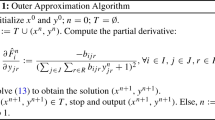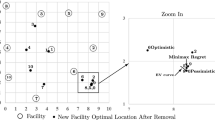Abstract
In this paper, we present efficient solution approaches for discrete multi-facility competitive interaction model. Applying the concept of “Tangent Line Approximation” presented by the authors in their previous work, we develop efficient computational approaches—both exact and approximate (with controllable error bound α). Computational experiments show that the approximate approach (with small α) performs extremely well solving large scale problems while the exact approach performs very well for small to medium-sized problems.
Similar content being viewed by others
References
Aboolian, R. (2002). Competitive facility location and design problem. Ph.D. Thesis, University of Toronto, Toronto, Canada.
Aboolian, R., Berman, O., & Krass, D. (2007). Competitive facility location model with concave demand. European Journal on Operational Research, 181, 598–619.
Achabal, D., Gorr, W. L., & Mahajan, V. (1982). MULTILOCC, a multiple store location decision model. Journal of Retailing, 58, 5–25.
Bazaraa, M. S., & Shetty, C. M. (1979). Nonlinear programming: theory and algorithms. New York: Wiley. (pp. 454, 490, 491).
Bazaraa, M. S., Sherali, H. D., & Shetty, C. M. (1993). Nonlinear programming, theory and algorithms, 2nd edn. New York: Wiley.
Berman, O., & Krass, D. (1998). Flow intercepting spatial interaction model: a new approach to optimal location of competitive facilities. Location Science, 6, 41–65.
Bretthauer, K.M., & Shetty, B. (2002). The nonlinear knapsack problem—algorithms and applications. European Journal of Operational Research, 138, 459–472.
Caprara, A., Pisinger, D., & Toth, P. (1999). Exact solution of the quadratic knapsack problem. INFORMS Journal on Computing, 11, 125–137.
Davies, R. L., & Rogers, D. S. (1984). Store location and store assessment research. New York: Wiley.
Drezner, T. (1994). Optimal continuous location of a retail facility, facility attractiveness, and market share: an interactive model. Journal of Retailing, 70(1), 49–64.
Drezner, T. (1995). Competitive facility location in the plane. In Z. Drezner (Ed.), Facility location (pp. 291–298). Berlin: Springer.
Drezner, T., & Drezner, Z. (1997). Replacing discrete demand with continous demand in a competitive facility location problem. Naval Research Logistics, 44, 81–95.
Drezner, T., & Salhi, S. (2002). Solving the multiple competitive facilities location problem. European Journal of Operational Research, 142, 138–151.
Dussault, J. P., Ferland, J. A., & Lemaire, B. (1986). Convex quadratic programming with one constraint and bounded variables. Mathematical Programming, 36, 90–104.
Gallo, G., Hammer, P. L., & Simon, B. (1980). Quadratic knapsack problems. Mathematical Programming, 12, 132–149.
Ghosh, A., & Craig, C. S. (1984). A location-allocation model for facility planning in a competitive environment. Geographical Analysis, 20, 39–51.
Ghosh, A., & Craig, C. S. (1987). Location strategies for retail and service firms. Lexington: Lexington Books.
Ghosh, A., & Craig, C. S. (1991). FRANSYS: a franchise location model. Journal of Retailing, 67, 212–234.
Ghosh, A., McLafferty, S. L., & Craig, C. S. (1987). Multifacilty retail networks. In Z. Drezner (Ed.), Facility location (pp. 301–330). Berlin: Springer.
Hillsman, E. L., & Rhoda, R. (1978). Errors in measuring distances from populations to service centers. Annals of Regional Science, 12, 74–88.
Huff, D. L. (1962). Determining of intra-urban trade areas. Real estate research program, UCLA.
Huff, D. L. (1964). Defining and estimating a trade area. Journal of Marketing, 28, 34–38.
Huff, D. L. (1966). A programmed solution for approximating an optimum retail location. Land Economics, 42, 293–303.
Klastorin, T. D. (1990). On a discrete nonlinear nonseparable knapsack problem. Operations Research Letters, 9, 233–237.
Lea, A. C., & Menger, G. L. (1990). An overview of formal methods for retail site evaluation and sales forecasting. Part 2. Spatial interaction models. The Operational Geographer, 8, 17–23.
Nakanishi, M., & Cooper, L. G. (1974). Parameter estimates for multiplicative competitive interaction models-least square approach. Journal of Marketing Research, 11, 303–311.
Plastria, F. (1992). GBSSS, the generalized big square small square method for planar single facility location. European Journal of Operations Research, 62, 163–174.
Author information
Authors and Affiliations
Corresponding author
Rights and permissions
About this article
Cite this article
Aboolian, R., Berman, O. & Krass, D. Efficient solution approaches for a discrete multi-facility competitive interaction model. Ann Oper Res 167, 297–306 (2009). https://doi.org/10.1007/s10479-008-0337-y
Received:
Accepted:
Published:
Issue Date:
DOI: https://doi.org/10.1007/s10479-008-0337-y




